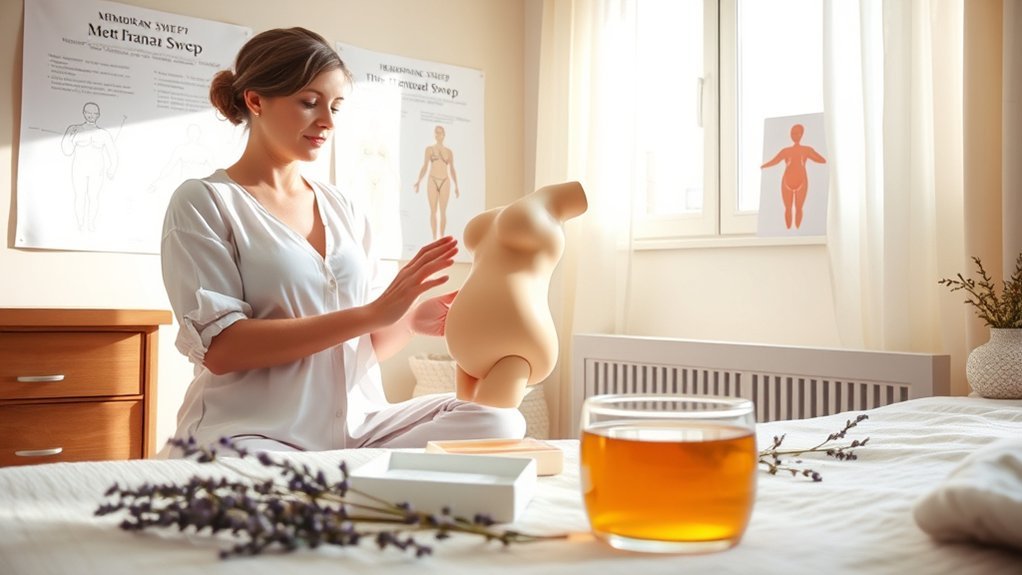A membrane sweep is often considered to induce labor when necessary, but there are ways to potentially avoid this intervention. By maintaining a healthy lifestyle during your pregnancy, you can support your body’s natural processes. Nutrition, exercise, and hydration play vital roles in your overall well-being. Understanding how these factors contribute to labor readiness is essential. Let’s explore effective strategies to minimize the likelihood of needing a membrane sweep.
Understanding Membrane Sweeps and Their Purpose

When you approach the end of your pregnancy, understanding membrane sweeps and their purpose becomes essential.
A membrane sweep, also known as a cervical sweep, is a procedure performed by your healthcare provider to help stimulate labor. During this process, your provider inserts a finger into your cervix and gently separates the amniotic sac from the uterine wall. This action releases hormones called prostaglandins, which can trigger contractions.
While it’s typically done after 39 weeks, it may be recommended earlier for specific medical reasons. Understanding the procedure’s intent can help alleviate anxiety, aiding in informed decision-making regarding your birth plan.
Always discuss any concerns with your healthcare provider to guarantee you’re comfortable with the options available to you.
Maintaining a Healthy Lifestyle During Pregnancy

As you approach labor, maintaining a healthy lifestyle during pregnancy plays an essential role in ensuring both your well-being and that of your baby. Focus on balanced nutrition, regular physical activity, and adequate hydration. Avoid harmful substances, including tobacco and alcohol. Prioritize prenatal care to monitor your health and your baby’s development.
| Aspect | Recommendations | Benefits |
|---|---|---|
| Nutrition | Eat fruits, vegetables, whole grains | Supports fetal growth and development |
| Exercise | Engage in moderate activity, like walking | Improves mood and reduces discomfort |
| Hydration | Drink plenty of water | Aids in digestion and circulation |
| Sleep | Aim for 7-9 hours per night | Enhances recovery and overall health |
| Prenatal Care | Attend regular check-ups | Early detection of complications |
Natural Methods to Encourage Labor

Exploring natural methods to encourage labor can be beneficial for those nearing their due date. One common technique is walking, which helps gravity assist in positioning the baby and may stimulate contractions.
You might also consider engaging in sexual intercourse, as it releases prostaglandins that can soften the cervix. Additionally, nipple stimulation can promote the release of oxytocin, potentially triggering contractions.
Drinking raspberry leaf tea is another option; it’s believed to tone the uterus. Acupuncture and acupressure are alternative methods that some find useful in stimulating labor.
Always consult with your healthcare provider before trying these methods to guarantee they’re appropriate for your individual situation. Prioritizing safety is essential for you and your baby during this critical time.
Importance of Regular Prenatal Care
Regular prenatal care plays an essential role in guaranteeing a healthy pregnancy and delivery. By attending routine check-ups, you can monitor your baby’s development and identify any potential complications early.
These visits provide an opportunity for healthcare professionals to assess your overall health, track weight gain, and perform necessary screenings and tests. You’ll receive guidance on nutrition, exercise, and lifestyle choices that can positively impact your pregnancy.
Regular check-ups allow healthcare professionals to monitor your health, provide essential screenings, and offer valuable guidance for a healthy pregnancy.
Additionally, prenatal care allows you to discuss any concerns or questions you may have, fostering a supportive environment. Staying consistent with your appointments not only helps guarantee your well-being but also prepares you for labor and delivery.
Prioritizing prenatal care is a vital step in achieving a safe and successful pregnancy experience.
Emotional Well-being and Its Impact on Labor
Emotional well-being greatly influences labor outcomes, impacting both the physical and psychological experiences of childbirth. When you’re feeling anxious or stressed, your body may produce higher levels of cortisol, which can inhibit the progress of labor.
Conversely, positive emotions can enhance your pain tolerance and lead to a more efficient labor process. Engaging in relaxation techniques, such as deep breathing or visualization, can help promote a calm environment, facilitating smoother contractions.
Additionally, having a supportive partner or doula can markedly boost your confidence, reducing feelings of fear and uncertainty. Remember, addressing your emotional health isn’t just beneficial for you; it can also positively affect your baby’s experience during labor and delivery.
Prioritizing your emotional well-being is essential for a healthier childbirth experience.
Frequently Asked Questions
Are There Any Risks Associated With a Membrane Sweep?
Yes, there are risks associated with a membrane sweep. You might experience discomfort, bleeding, or infection. Additionally, premature labor could occur, so it’s essential to discuss these potential risks with your healthcare provider beforehand.
How Effective Is a Membrane Sweep in Inducing Labor?
A membrane sweep can gently encourage labor, with effectiveness varying from person to person. Many find it helpful, but results aren’t guaranteed. It’s important to discuss expectations and alternatives with your healthcare provider.
When Is the Best Time to Have a Membrane Sweep?
The best time to have a membrane sweep is typically between 39 and 41 weeks of pregnancy. It’s essential to consult your healthcare provider to determine the most appropriate timing based on your individual circumstances.
Can I Decline a Membrane Sweep if Offered?
Yes, you can decline a membrane sweep if offered. It’s crucial to discuss your concerns with your healthcare provider to guarantee you make an informed decision that aligns with your preferences and overall birth plan.
What Should I Expect During a Membrane Sweep Procedure?
During a membrane sweep, you’ll feel pressure and possibly discomfort as your healthcare provider gently separates the membranes from your cervix. You might experience cramping and spotting afterward, but most women tolerate the procedure well.
Conclusion
In conclusion, by prioritizing a healthy lifestyle, engaging in regular prenatal care, and discussing your preferences with your healthcare provider, you can effectively reduce the likelihood of needing a membrane sweep. Just like a well-tended garden flourishes, your proactive approach to pregnancy can lead to a smoother labor experience. Remember, every step you take towards your well-being not only benefits you but also nurtures the growth of your baby. Embrace this journey with confidence and care.
